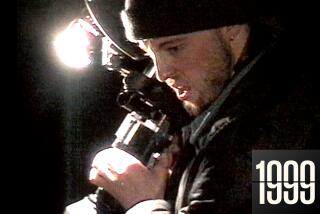The Wide World of the ‘Star Wars’ Web
- Share via
The first two-minute trailer for “Star Wars: Episode I The Phantom Menace” was not even completed when the Internet made it old news.
Last October, the Sydney, Australia-based https://www.darkhorizons.com posted a detailed shot-by-shot breakdown of the trailer, complete with camera angles, on the World Wide Web.
Even then, seven months before its release date, the first “Star Wars” prequel had proved a favorite Web topic. In addition to the official https://www.starwars.com, there were dozens of other fan sites devoted to reporting every detail--some confirmed, some not--about George Lucas’ sci-fi franchise (from https://www.theforce.net to https://www.jedinet.com). Nevertheless, in cyberspace the trailer preview was considered a coup.
“I got 140,000 hits on that day, which is about double normal,” said Garth Franklin, the site’s 21-year-old creator, who considered his “Star Wars” item even better than his previous exclusive: a description of the opening scene of “Scream 2,” posted seven months before release. “It’s definitely the biggest scoop I’ve ever had.”
With its futuristic themes and gee-whiz gadgetry--which both appeal to people who are likely to be computer-friendly--the “Star Wars” franchise has become ground zero for movie-related Web activity. According to Media Metrix, which rates Internet services by volume, Lucasfilm’s official site recently joined the top 50 most visited Internet destinations.
But in addition to showing just how popular movie sites can be, the “Star Wars” frenzy also is an instructive example of how the Internet, if used shrewdly, can be put to work.
Jim Ward, head of marketing at Lucasfilm, said the official site was partly born out of an awareness that especially after the first three “Star Wars” films were re-released in 1997, a new generation of fans was created--one that happened to be very Web-savvy. The site was always intended, however, as more than a sales pitch.
“Our site was really established as a way for us to communicate with our core fans. They’ve sustained us all these years, and we wanted to make sure there was one place they could go to get the official information as promptly as possible,” Ward said.
“But beyond that, we have a store and a lot of entertainment elements--the Web documentaries, Lynne Hale’s diary,” Ward continued, referring to a video record of the making of the latest film that can be viewed via the Web site. “The site itself is not just a marketing tool or another medium to launch this film. It is a destination in and of itself--a place to purchase merchandise, to experience aspects of all the films. It’s an entertainment mecca.”
Indeed, don’t try to read, watch and listen to all the information on the “Star Wars” site if you have anything else to do today. There are interviews, announcements about fan club events, tidbits, trivia. There are copies of the trailers, a photo of the poster and countless interviews and essays about the past, present and future of the franchise. More than merely fueling fans’ interest, the site helps blur the traditional definition of what it means to be a consumer by encouraging people to feel integrally--and actively--involved with a product as it is being created.
To that end, Lucasfilm has mostly welcomed the scores of unofficial “Star Wars” sites (Ward singles out www.theforce.net as doing “a bang-up job”). But the company draws the line when fans try to make a buck.
“If, in fact, they’re using our materials in a commercial sense, we do need to go after them. That’s something we have done and will do,” whether fans are peddling a poster or a copy of the entire film, Ward said. “Piracy is a huge issue, and not just for our film. We need to be prepared for it.”
The trick, it seems, is to make fans feel they have a stake in a project whether they have one or not. Lucasfilm has pioneered this approach to the Internet, but it isn’t alone. Producer David Friendly, for example, is contemplating creating a Web site to promote his next film, a feature-length teen romance (starring Leelee Sobieski) that starts shooting in Minnesota next month. The idea, he said, is to use the Internet to spur interest from the very beginning of production, not just in the weeks leading up to the film’s release.
“I don’t want to go into too much detail, but it’s going to be an unusual amount of information about a movie as it’s being made,” said Friendly, who said he fully expects the Internet to become an integral part of movie-making in the future. “Very soon people will say, ‘How did we make movies without it?’ ”
More to Read
The biggest entertainment stories
Get our big stories about Hollywood, film, television, music, arts, culture and more right in your inbox as soon as they publish.
You may occasionally receive promotional content from the Los Angeles Times.










